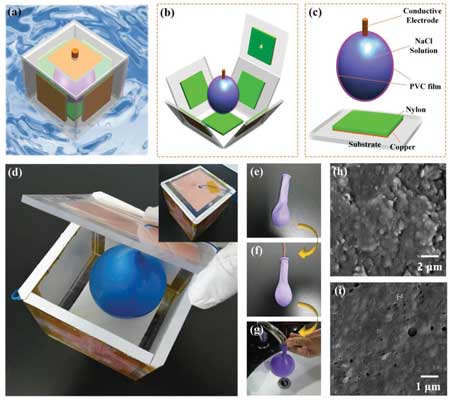| Aug 13, 2020 | |
Balloon nanogenerator harvests energy from water waves(Nanowerk News) Ocean energy is a huge, mostly untapped source of renewable energy that is inexhaustible and no pollution, and it is the richest, clean, and reproducible energy on our earth. |
|
| However, the current energy harvesting technologies for ocean wave energy are still inadequate and not suitable for large-scale deployment. For instance, energy harvesters for wave energy based on electromagnetic generation is unable to efficiently work under the irregular vibration of ocean waves. | |
| Recent developments have shown that triboelectric nanogenerators (TENGs) can effectively convert low frequency and amplitude mechanical energy into electrical energy. Already, this concept has been applied to ocean waves (read more: "Matryoshka-inspired hierarchically structured triboelectric nanogenerators for wave energy harvesting"). | |
| Researchers in China now have developed this concept further by proposing a novel multiple-frequency triboelectric nanogenerator based on a water balloon (WB-TENG) to harvest water wave energy. They report their findings in Advanced Energy Materials ("Multiple-Frequency High-Output Triboelectric Nanogenerator Based on a Water Balloon for All-Weather Water Wave Energy Harvesting"). | |
| The proposed WB-TENG consists of two parts, the square box and a water balloon, where the square box is composed of six identical acrylic plate coated covered with a layer of conductive copper foil and a layer nylon film. A certain ratio of sodium chloride is added to the water to increase conductivity, and the water is injected into the balloon to form the water balloon. | |
| Specifically, the balloon film and nylon serve as the triboelectric materials, where the composition of balloon film is polyvinyl chloride (PVC), and the copper foil and water with a little sodium chloride both play the role of conductive electrodes. | |
 |
|
| a) Schematic diagram of the WB-TENG floating on water. b) Structure expansion diagram of the WB-TENG. c) The internal structure of the water balloon and the acrylic substrate coated with copper foil film and nylon film. d) The photography of the WB-TENG. e–g) The preparation process of the water balloon. h,i) The SEM images of the balloon film and nylon film surface. (Reprinted with permission by Wiley-VCH Verlag) (click on image to enlarge) | |
| As the authors point out, owing to the high elasticity of the water balloon, the WB-TENG can realize multiple-frequency response to the low-frequency external mechanical stimulations and generate high-frequency electrical output. | |
| Also, the water balloon doesn't require any additional supporting structure because of its tension, thus making it a self-supporting energy harvester. | |
| The researchers note that the maximum instantaneous short-circuit current and open-circuit voltage can arrive at 147 µA and 1221 V, respectively, and under a match load of 20 MΩ, the maximum instantaneous output power can reach 13.52 mW. | |
| "As a result of the unique working mechanism, the WB-TENG presents a novel potential application for developing blue energy in the field of the ocean," the team concludes.. |
 By
Michael
Berger
– Michael is author of three books by the Royal Society of Chemistry:
Nano-Society: Pushing the Boundaries of Technology,
Nanotechnology: The Future is Tiny, and
Nanoengineering: The Skills and Tools Making Technology Invisible
Copyright ©
Nanowerk LLC
By
Michael
Berger
– Michael is author of three books by the Royal Society of Chemistry:
Nano-Society: Pushing the Boundaries of Technology,
Nanotechnology: The Future is Tiny, and
Nanoengineering: The Skills and Tools Making Technology Invisible
Copyright ©
Nanowerk LLC
|
|
|
Subscribe to a free copy of one of our daily Nanowerk Newsletter Email Digests with a compilation of all of the day's news. |
